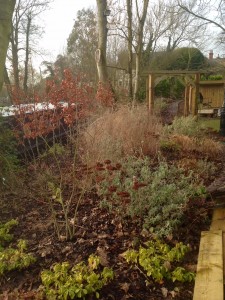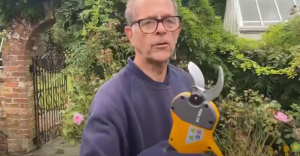
The last few weeks have really been trying for us gardeners, and have certainly caused us at Writtle University College to amend our timetables to accommodate the weather. Nonetheless, we’ve had all our classes on the grounds able to still undertake a number of jobs.
Only last week my RHS Level 3 Certificate in Practical Horticultural students managed to get a good number of shrub roses pruned and take the opportunity to start learning to identify conifers… a challenging plant identification test for the best of us!
With the shrub roses, which tend to flower on previous season’s wood, my group proved a dab hand at pruning them.
In order to get them all set for the new growing season they should be pruned in the following way:
1. Remove dead, diseased and damaged growth.
2. Remove last year’s flowering wood either to the ground, or to where there is a strong well spaced vegetative shoot by cutting to an outside facing bud.
3. Cutting to outward facing buds encourages greater airflow and as a result reduced diseases such as blackspot, rust and or mildew.
4. When pruning, take your time to stand back and look at the overall shape. Try to develop a goblet or vase form and always consider neighbouring plants.
5. Prunings can be recycled by chipping and shredding if free of disease… if not pop into your municipal waste or incinerate.
As it was still frosty in parts on the campus mulching will occur in March once feeding has taken place. Use a strong potash rich feed for roses, such as Top Rose, to enhance flowering and good all round growth. Lightly incorporate the feed and then add a generous mulch of well rotted organic matter. We’ll be using compost produced at the college and adding it around plants to a depth of 10cm (4″).

A task that we’ve delayed due to the frosty conditions is lifting and dividing perennials. It looks like later this week or at least by early February we should be able to get on with this important and necessary job. Perennials need lifting up totally every 3-5 years as they die out in the centre and or spread out and take over beds. This technique also enables for the invigoration of the soil and the potential to redesign. It also gives you a huge number of spare plants for friends and family.
Lastly, if the weather remains cold don’t forget that there are loads of other jobs to do. Check out these:
1. Keep paths and drives free of leaf litter; this reduces slippage for those walking over them and also removes debris that can be composted.
2. Continue to prune climber/ rambler roses plus bush and shrub types.
3. Clean down greenhouse structures including benches, pots and canes. I use a disinfectant to surface sterilise all areas.
4. Don’t forget those house plants; reduce watering and move to where the light is best to ensure good even growth. For orchids use a drip feeder – all good garden centres will stick them.
Happy gardening… and take the time to visit a local garden near you. Ever so slightly biased, but I do love to visit RHS Garden Hyde Hall over in Rettendon. Give them a call to check out any events/ activities on 0845 265 8071
For any gardening tips why not contact Tom Cole, Senior Horticultural Lecturer, Writtle College, Chelmsford, CM1 3RR by post (including a SAE) or by email at tom.cole@writtle.ac.uk








